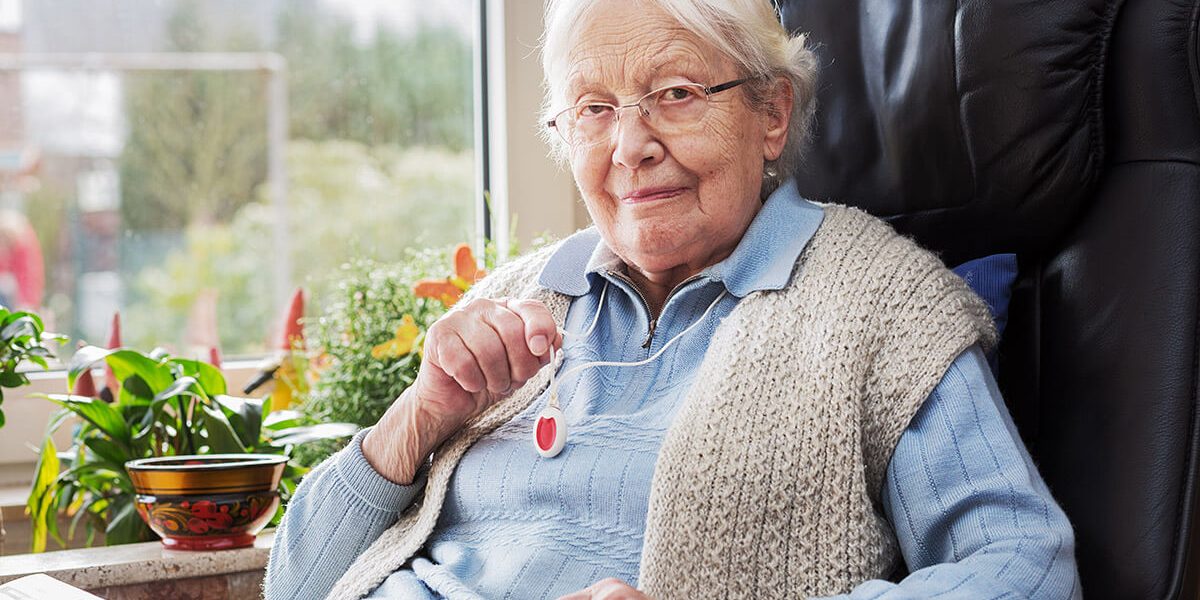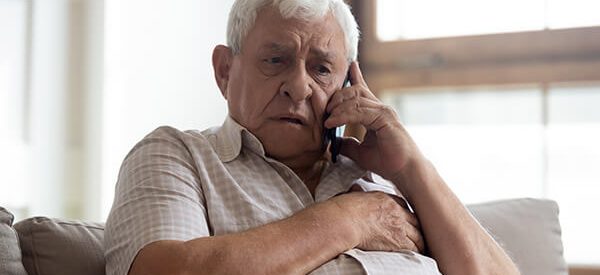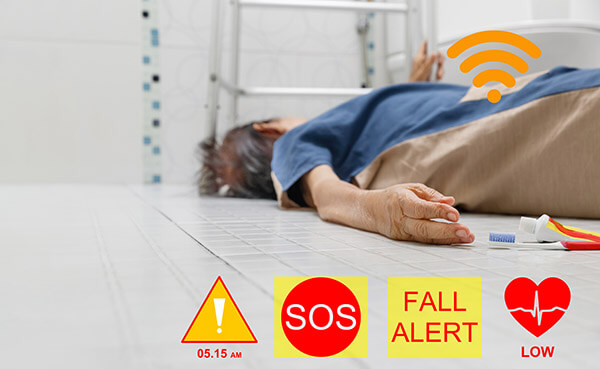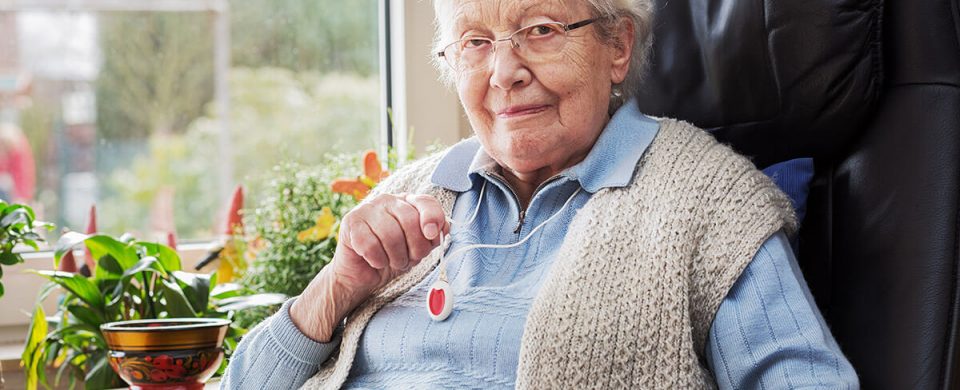
Wearable Panic Buttons VS Smartphones: 5 reasons they are better for seniors

Smartphones have changed our lives in more ways than we can imagine. They have given us instant access to endless entertainment and information. They have also made it very easy to keep in touch with friends and family, near or far.
And while this handheld device can be carried around, when it comes to your safety, it is not enough.
In some emergencies, a smartphone may not be the best solution to getting the HELP that you need.
Have you ever tried calling someone only to get a busy signal or no answer? In a medical emergency, it can have dire consequences.
This is why wearable emergency panic buttons are better for seniors when it comes to safety and protection. You will never get a busy signal or fail to reach someone. Professional staff will always respond to a distress call IN SECONDS!
To find out how much these wearable panic buttons cost, fill out the form below to get FREE and NO COMMITMENT quotes
Top 5 Reasons Panic Buttons are a MUST for seniors

According to Statistics Canada, there were almost 5 million seniors aged 65 and above in Canada as of 2011. More than 92% of these individuals were living alone or as a couple. It is quite likely that these numbers have increased since then, due largely to improved life expectancy.
Another reason why more seniors can now live independently is the advent of medical alert systems and emergency panic buttons.
And while smartphones have made it easy for family members to stay in touch, panic buttons have become more efficient in terms of calling for help. Here are 5 reasons why panic buttons are a must for seniors.
#1 Smartphones don’t have 100% accessibility while panic buttons are 100% accessible.
Although you can always carry a smartphone, it may not be within reach in an emergency. An accident such as a fall can happen in a blink of an eye. It can be knocked away, left on a desk, or worse get broken when it falls. A panic button can be work on the neck or wrist, making it far easier to reach in a split second. It can be on your body 100% of the time.
#2 Smartphones take longer to operate while a panic button takes only 1 push of a button to work.
How many seconds or minutes will it take you to dial a number or send a text message asking for help? And how many seconds or minutes will it take for someone to answer or reply? While smartphones are simple to operate, they could take longer in an emergency, especially if the person is injured, anxious, or disoriented. In an emergency, every second matters.
#3 Smartphones can’t be worn in the bath while panic buttons are waterproof.
Many accidents in the home occur in the bathroom. It would be unlikely for a senior to have a smartphone within reach while in the bath. On the other hand, many panic buttons are waterproof and can be worn in the bathroom. This ensures that a senior can easily press the help button in case of an accident.
#4 Panic buttons have fall detection technology but smartphones don’t.
Without a doubt, falls are among the most common accidents experienced by seniors. According to the Public Health Agency of Canada’s report on elderly falls, 20% to 30% of seniors fall every year. Studies also show that 95% of hip fractures are directly related to falls, with 20% of them leading to death. Falls are also cited as a catalyst for moving to long-term care.
When a senior has a fall, he could become unconscious or injured and unable to call on the phone for help. Emergency panic buttons and medical alert systems offer fall detection technology which means help comes even when the user was not able to press the panic button.
#5 Emergency panic buttons are connected to monitoring centers that operate 24/7, 365 days a year.
People take vacations, go to sleep, get busy with work, or miss messages. When you rely on a relative to help, they could be unavailable sometimes. If you have a medical emergency or are in danger, you want assurance that somebody will respond immediately.
Worry no more because emergency panic buttons connected to monitoring centers are always on hand to take your call. They never go on a break or a vacation. With one press of a button, someone will be on the line to send help immediately.
Wearable panic buttons – the ultimate protection for seniors

Why would you need a wearable panic button when you already have a smartphone? This is probably a question you have been asking a concerned relative who wants you to use a medical alert system.
According to security experts, it is not possible for anyone to have a smartphone on hand all the time. You may be watching TV with your smartphone on a side table, get up from your chair, and fall. Your smartphone will be out of reach.
If you have an accident and have no personal emergency response system on your person, you are at risk.
This is why wearable panic buttons are a MUST for seniors. These devices offer many other advantages such as wireless operations to give you non-stop coverage. They also offer GPS tracking and medication reminders to make seniors as safe as possible.
Wearable panic buttons do away with the need to dial a phone to summon help. When it is connected to a reliable monitoring center, an emergency signal is received by qualified and trained staff. Depending on your emergency, they can contact a family member, or summon the police, fire department, or an ambulance.
These systems, when equipped with auto fall detection, alert a monitoring center if you fall even when you can’t speak. GPS tracking allows your location to be traced in case you are outside the home.
Are you convinced that you or an elderly loved one can benefit from an emergency panic button? Compare quotes from our reliable partners to save time and money today! Fill out the short form on this page to get NO OBLIGATION quotes.
What is fall detection and how does it work?
Fall detection is a technology found in portable devices that can identify a fall. It automatically sends an alert to someone to get assistance. This is true even if you don’t push the panic button in an emergency.
Let’s say you are walking in the park and you stumble and fall, hurt yourself and become unconscious, if you are wearing a fall detector, it will alert a monitoring center that you have an emergency.
When this happens, trained staff will try to reach you to verify your condition and check if you need assistance. If you don’t answer and their system shows that you may have fallen, they can send medical responders to your location quickly.
All these things happen in seconds (within 20 to 40 seconds of a fall) because in a medical emergency, time is of the essence.
Medical alert systems with fall detection feature

Fall detectors are not hard to find as there are many medical alert systems offering fall detection features. But you must study your options well and choose the best one that suits your needs.
You may have to pay extra to get automatic fall detection to upgrade your service but it is a huge benefit for anyone who lives alone and is worried about medical emergencies.
Medical alert system companies like Philips Lifeline, Global Security, and SecurMedic provide different plans to choose from.
You can choose a standard plan to cover your home, an upgraded plan with fall detection, or plans with extended coverage that work outside the home and have automatic fall detection and GPS monitoring.
Automatic fall detection is very important for medical alert system users with:
- A history or fear of falls
- Chronic medical conditions
- Taking medications with side effects
- Recuperating from an injury or surgery
- With mobility or balance issues
Depending on your lifestyle and your needs, you can customize your plan to make sure that you can live independently without fear or worry.
Find out more about getting fall detection as an added layer of protection from your medical alert system.
You’ll be surprised to know that some medical alert systems can cost as little as $1 a day and give you the freedom to live your life in comfort and with confidence.
How reliable is fall detection technology?
Many medical alert systems use a pendant or wristband with a button to press to call for help. There are, however, seniors who are more at risk for falling and may be incapable of pressing the button after a fall. This is where automatic fall detection can greatly help.
When a fall detector senses a fall, it automatically sends a fall alert. The user has a few seconds to press the button to cancel the alert. If not, the monitoring center will send help to your location.
How reliable is this technology?
Fall alert detectors can identify a user’s position, the speed of movement, and how abrupt or smooth the movement is. Based on these parameters, a fall detector will identify a potential fall. The technology varies from one company to another and reliability depends on your chosen provider.
The technology is not perfect, and the system can register a fall that is not when you lose your balance for a moment. However, false alerts are few and you can cancel a false alert simply by pressing the button.
But think for a moment – in an actual fall and you are unable to press the button- an automatic fall detector can save your life.
Why medical alert systems are essential for seniors
Studies show that 1 in 3 people over the age of 65 falls. Most of them don’t tell anyone.
These falls can’t be predicted. A senior could trip on a curb or slip in the shower. You may suddenly feel dizzy or feel a tightening of your chest and go down.
There are many reasons to wear a medical alert system and the decision to use a wearable device is yours to make.
Why you may need an emergency panic button or medical alert system:
- Do you live alone?
- Are you using a walker, cane, or a wheelchair?
- Do you have mobility, balance, or memory problems?
- Are you living with a serious medical condition or illness?
- Do you take daily medications that leave side-effects?
- Have you experienced a fall?
- Are you worried about needing medical services in an emergency?
- Would you like to remain independent in your home?
If you have answered yes to some or all of these questions, you have every reason to need an emergency panic button.
Wouldn’t you feel more confident to enjoy life if you know that help, when there is an emergency, is just a press of a button away?
How to choose the best medical alert system for you
Are you considering a medical alert system? There are many features, service plans, and fees that could make it challenging to choose the right one.
4 Essential Questions to Ask yourself First
Once you are ready to shop for the best medical alert system, you must make 3 essential decisions regarding your choice.
Do you want a monitored or non-monitored system?
You can also choose between a monitored or non-monitored system. Monitored medical alert systems are connected to certified monitoring centers with 24/7 assistance available, 365 days a year. Professional staff attend to all emergency alerts and handle notification of family, fire, police or medical responders.
Non-monitored systems, on the other hand, work as a dialer to contact designated people in an emergency or 911.
Monitored systems have monthly monitoring fees. If you have no family members available to respond quickly to an emergency or you don’t want to give them this burden, you may opt for a monitored system. The monthly monitoring fee can be as low as $1 a day but you can take advantage of more features for your safety.
Do you need a home system or mobile system?
While medical alert systems are designed to protect you at home, companies also offer extended coverage for outdoor use.
Home-based systems are connected to a landline and work only inside the home. Once you step into the yard or go out, you won’t have coverage. It is important to ask the range covered by the system as some have 200ft to 600 ft. while others can have as much as 1000 ft. Thus, the size of your home is also an important consideration as you need protection wherever you are at home.
If you have an active lifestyle or spend time outdoors by yourself (shopping, recreation, etc.), a wireless system with fall detection may be the best option for you.
Wireless systems operate over cellular networks and allow the monitoring center to locate you during an emergency if you can’t press the button or speak.
Do you need a basic plan or an advanced system with fall detection?
Basic plans for medical alert systems require the user to push the panic button in an emergency. When the button is pressed, an alert is received by the monitoring center who then verifies the situation and summons the appropriate responders. The emergency button also allows the user to speak to the monitoring center using the built-in 2- way communication system. This means you don’t need to dial a phone to call.
Customers can opt for plans with automatic fall detection. With this feature, the device identifies a potential fall using set algorithms and alerts the monitoring center, even if the user fails to press the button.
Wireless systems are more expensive but they offer additional features like fall detection, Geo-fencing, and GPS tracking.
Do you want a contract for the monitoring service?
Some of the best medical alert systems require a contract for the monitoring service (24 to 36 months). This means that if you cancel before the contract ends, you may be charged a cancellation fee.
While this can seem disadvantageous, it is important to also consider the overall plan and the quality of the service. There are medical alert systems that don’t require any long-term commitment and can be canceled at any time. It is crucial to assess if their package is adequate to meet your needs.
If you are buying a medical alert system for someone special such as a parent or a grandparent, experts advise talking it over with the person to see what they prefer and what features are desired. This will ensure that the device will be a perfect match to their needs.
Compare Emergency Panic buttons that match your needs
Don’t be overwhelmed with the variety of choices in the market. We can help you find the right emergency panic button for seniors that suits your needs and budget.
Our partners, reputable and experienced in the field of security and medical alert systems, can offer you competitive prices for efficient and reliable panic buttons.
When you fill out the short online form below, you will receive FREE and NO COMMITMENT quotes you can compare and choose from. Save time and money when shopping for your emergency panic button.
While our partners offer only monitored systems, their reliability is guaranteed and worth the price!
Don’t compromise your security with just a smartphone to protect you. You can live independently and enjoy brand-new confidence with a reliable medical alert system for seniors.
Comments are closed.

Copyright© 2025 Compare Home Quotes.
Oolong Media






